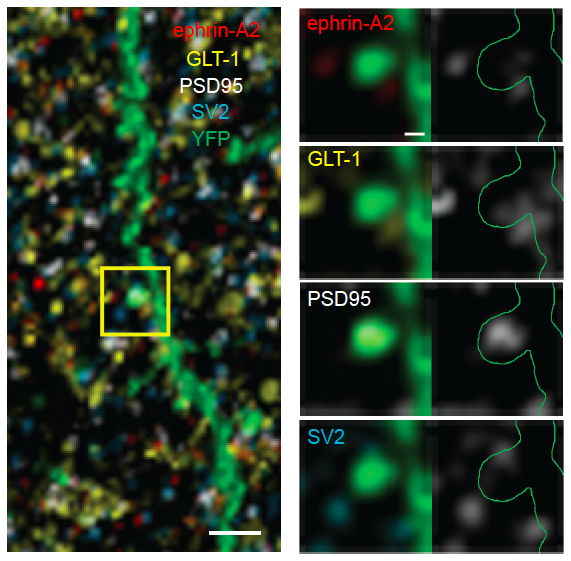
Postnatal maturation of the brain requires pruning of excess synapses, a process that is dependent on sensory input and synaptic activity. Yuet al. found that Ephrin-A contributed to synapse stabilization in the cortex. In vivo, transcranial, two-photon microscopy of fluorescently labeled cortical pyramidal neurons showed thatephrin-A2–knockout mice ultimately had fewer dendritic spines than didephrin-A3–knockout or wild-type mice, despite starting with comparable numbers of spines at the beginning of imaging. Sensory deprivation by whisker trimming or inhibition of the glutamate receptor NMDAR by intraperitoneal injection of the small molecule MK801, each of which reduces spine elimination, abrogated the difference in spine elimination betweenephrin-A2–knockout and wild-type mice. Ephrin-A2 punctae were enriched near glutamate reuptake transporters, GLAST and GLT-1, on presynaptic astrocytic processes and were not detected on the postsynaptic dendritic spines, as shown by ultrastructural analysis in cortical sections using array tomography. Moreover, cortical slices fromephrin-A2–knockout mice had decreased abundance of GLAST and GLT-1 and enhanced evoked excitatory postsynaptic potentials, consistent with the presence of excess glutamate in the synaptic cleft. Direct inhibition of GLT-1 by intraperitoneal injection of mice with dihydrokainate also enhanced cortical synapse elimination. Thus, these data indicate that Ephrin-A regulates synaptic glutamate concentration and promotes activity-dependent stabilization of cortical synapses.
X. Yu, G. Wang, A. Gilmore, A. X. Yee, X. Li, T. Xu, S. J. Smith, L. Chen, Y. Zuo, Accelerated experience-dependent pruning of cortical synapses inEphrin-A2knockout mice.Neuron80, 64–71 (2013).[PubMed]
Citation:J. D. Berndt, Ephrin-A2 Un-Glu’s the Synapse.Sci. Signal.6, ec242 (2013).
